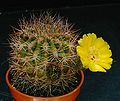| Acanthocalycium | |
|---|---|
 | |
| Acanthocalycium spiniflorum | |
| Scientific classification | |
| Kingdom: | Plantae |
| Clade: | Tracheophytes |
| Clade: | Angiosperms |
| Clade: | Eudicots |
| Order: | Caryophyllales |
| Family: | Cactaceae |
| Subfamily: | Cactoideae |
| Tribe: | Cereeae |
| Subtribe: | Trichocereinae |
| Genus: | Acanthocalycium Backeb. [1] |
| Type species | |
| Acanthocalycium spiniflorum | |
| Species | |
Acanthocalycium is a genus of cactus consisting of several species from Argentina, Bolivia, Brazil, Paraguay and Uruguay. [1] The taxon name comes from Greek akantha (meaning prickly) and kalyx (meaning buds), which refers to the spines on the floral tubes. [2]





